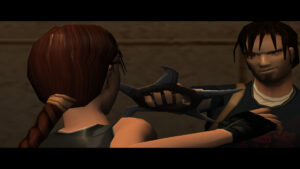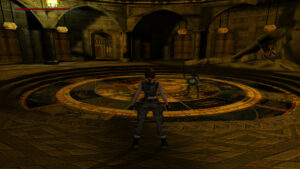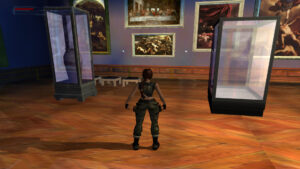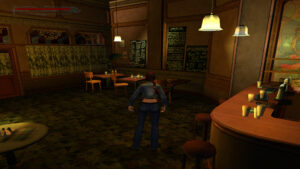TR6: In which I assert that Lara Croft resembles Jessica Fletcher
In the lower depths of the secret research complex under Prague — like Amnesia, this game largely equates progress with downward motion — Lara runs into Kurtis again, and again he constrains and disempowers her, trapping her in an airlock to keep her from causing any more trouble than she already has. And he has something of a point: Lara’s ingress involved shutting off the power to the security systems, which were also the systems keeping the monsters under control. She’s literally meddling in things she doesn’t understand, and for the first time in her life someone is effectively holding her accountable for her actions. It still bodes ill for their budding relationship, though. I can’t imagine Lara Croft accepting someone who keeps trying to control her like this.
While Lara’s stashed, player control shifts to Kurtis. It’s a move that reminds me of the seasons of Murder, She Wrote where they experimented with protagonists other than Jessica Fletcher: it feels a little wrong, but it’s really not all that objectively different. The main effect is that it takes away the opportunity to ogle Lara, and thus makes me aware of the extent to which I was doing so: not a lot, as my attention is generally on the game’s challenges, but every once in a while. The sorcerous powers that Kurtis displayed in his first appearance are disappointingly limited to cinematics, and beyond player control. Early on, there’s a bit where he uses his “Far See” power to get a keycode from a post-it on the other side of a locked door, and afterward I kept thinking “I wish I could Far See right now. That would be nice.” It’s like they designed a special mechanic for the character and then didn’t get around to actually implementing it.
The really peculiar part is that we don’t really know what Kurtis is trying to accomplish. We’re just piloting him forward in the hope that he knows as much about what’s going on as he seems to. He seems to be a good guy, at least to the extent that he’s fighting the bad guys. He’s probably with the Lux Veritatis, the secret guardians of forbidden knowledge who have been battling dark alchemists for centuries. That would make him the enemy of Lara’s enemy, but not her friend. This is a pattern we’ve seen as far back as Tomb Raider II: You have two warring sides, one dedicated to securing and protecting a dangerous power, one that wants to seize that power for themselves and exploit it. Then Lara Croft enters the picture. Now there are three sides.
 Comments(0)
Comments(0)


